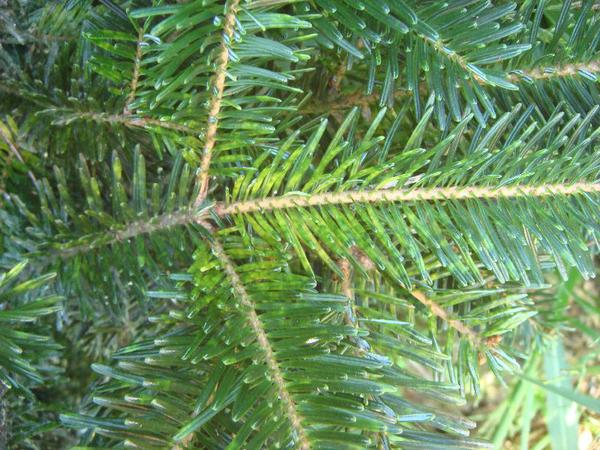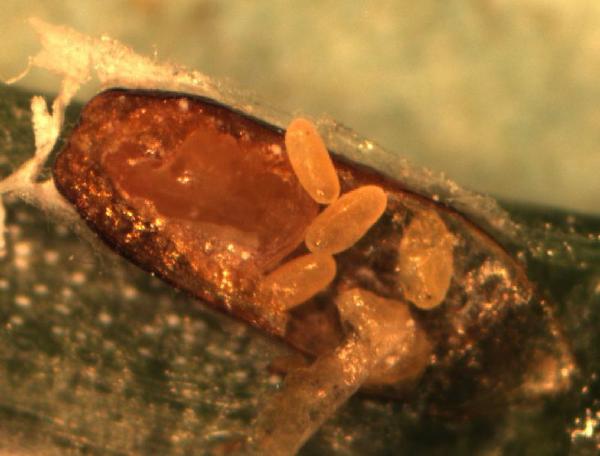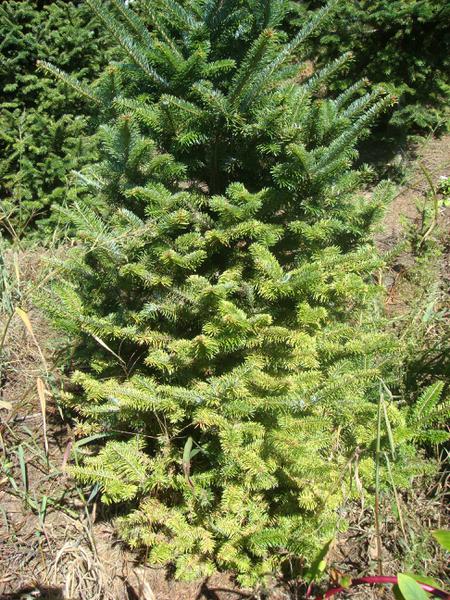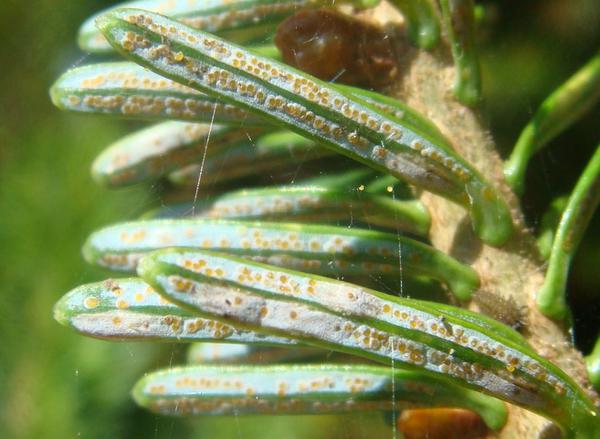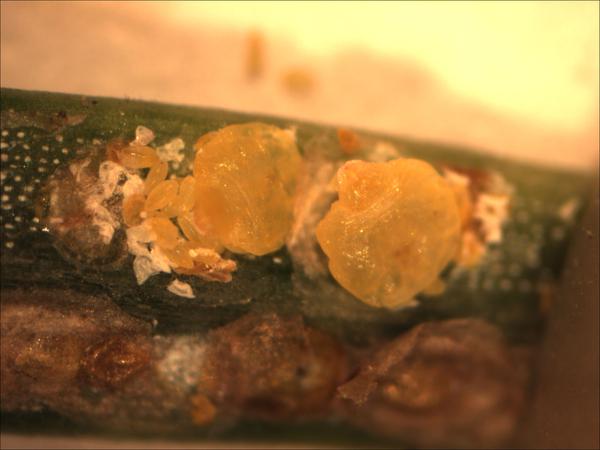Introduction
The elongate hemlock scale (Fiorinia externa), is an introduced pest from Asia. It belongs to the family Diaspididae, or armored scales. Though commonly associated with hemlocks, EHS can feed on many species of conifers including firs, pines, spruces, cedars, and Douglas fir. In western North Carolina, hemlocks and true firs including Fraser fir are its most common hosts.
Thought to have been first introduced into the US in New York City in 1908, the scale was slow to spread until the mid-1970s when it greatly expanded its invaded range and is now reported in more than 14 states in the eastern US and as far south as Georgia. First identified in North Carolina at the Biltmore Estate in Asheville on Momi fir, the pest was first found on Fraser fir Christmas trees in Yancey County in August 1993 on trees were growing among infested hemlocks. Through the 1990s, scales were sometimes observed, but were seldom a problem. However, since 2000, the prevalence of this pest has continued to increase until it is now a common problem. During this same time period, scale numbers were also increasing in hemlocks in the landscape in western North Carolina, in some instances damaging hemlocks before the hemlock woolly adelgid was found. It is also occasionally found on blue spruce and blue atlas cedar, though seldom causes much damage.
Effect on the Tree
The EHS is found almost exclusively on the underside of needles. Scales will be found on multiple years of growth. There can be as many as 30 scales on a single needle with scales sometimes found on top of each other.
When infestations are heavy, trees may have yellow blotches or patches on the needles and growth will be stunted (Figure 1). More commonly what is seen are the white, waxy excretions of the male scales found on the upper surface of needles especially during summer months when males are maturing (Figure 2). Infestations that do not reduce tree growth can still make trees unsaleable because of this white covering to the needles. This import of this pest is regulated by some states, and trees must be scale-free to ship to other countries.
Scale Appearance
EHS, as its name implies, is longer than it is wide. The males are white and females brown. Crawlers and immatures are yellow and are not elongated in shape. Crawlers have six legs and two tiny eyes.
The female scale is enveloped in a hard covering. There is only a small, shield-like opening underneath for the feeding tube to be inserted into the needle, otherwise she is completely protected from the outside world. Eggs are laid inside this envelope and crawlers, when they hatch, emerge from it.
The male develops in the white scale where they grow and eventually pupate into the adult. The adult males have wings and legs and are mobile so they are able to mate with the immobile females.
Life Cycle
EHS has two, overlapping generations in the southern Appalachians. Because of this overlap, all life stages can be found almost any time of year, though the proportion of one stage to another will vary. Crawlers emerge throughout the growing season and even in winter months, but peak crawler emergence is in late May into June. Because of this the best control with foliar applied insecticides is during this time period.
The crawlers must find an appropriate feeding site. Crawlers may move somewhere else on the same needle, crawl onto the new growth, or move passively through wind or bird movement onto other trees or fields. Active crawlers move from a few hours to a few days before inserting a stylet into the plant tissue. Once a feeding site is found they molt. If female, they will never move again. If male, they won't move until they are fully mature at which point they fly to find a female.
Immature scales appear to burrow under the waxy layer produced by the needle which provides added protection against pesticide applications and predators. As the scale matures, it forms behind the original yellow immature, making it look as if a smaller scale is attached to a larger. The feeding tube of the immatures is as long as it is, appearing as a tiny coppery wire that can be seen under a microscope if the scale is carefully pulled back away from the needle. EHS are known to feed by penetrating host tissues between epidermal cells to feed mostly on parenchyma cells (Rosen, 1990. Armored Scale Insects Their Biology, Natural Enemies, and Control). EHS do not exclusively feed from the water rich phloem sap like other insects such as aphids. EHS have very long stylets in relation to their body, likely to take nutrition from as much plant tissue as possible.
Immature female scales go through three stages of development while males have additional prepupal and pupal stages. Males emerge as a tiny winged insect with large black eyes and long antennas. Before they emerge, they can sometimes be found under the white cotton of the pupal stage. They have no mouth parts and live only a few days, mating with females. Eggs are produced six to eight weeks after mating. Each female produces 12 to 16 eggs at a time which hatch within a month. Mature females may live for more than one year. It takes about 16 weeks to go from a crawler through development to a new generation of crawlers being produced.
Cryptomeria Scale and Other Scales of Fraser Fir
Though EHS is the most common scale problem, there are other scales found on Fraser fir. The most damaging is Cryptomeria scale (Aspidiotus cryptomeria). Currently this scale is founded limited areas of Fraser fir production in western North Carolina and Virginia. Cryptomeria scale quickly damages trees with promenient mottling and needle shed which can occur within several weeks of infestation. Scales are found on the underside of needles and are round. There are two generations per year with peak crawler production in June and again in August. Control for Cryptomeria scale is similar to EHS.
Other scale pests are infrequent problems. These include pine needle scale (Chionaspis pinifoliae), hemlock scale (Hemiberlesia ithacae) and pine tortoise scale (Toumeyella parvicornis). To date, these have not been at a high enough density in trees to warrant control measures, but their presence can be of regulatory concern when shipping to other areas.
EHS Control
The elongate hemlock scale is difficult to control for several reasons. As an armored scale, it has a hard covering which makes pesticide penetration difficult. Since its life cycle is not synchronous, all life stages are almost always present, meaning that insecticides can not be applied at any given crawler emergence. Since it feeds in epidermal tissue instead of vascular tissue, it is not as easily controlled by systemic insecticides. Also as an introduced pest, it doesn’t have a lot of natural enemies, though there are several that feed on it.
Natural controls
In fact, at one time the EHS was considered to be “self-limiting.” In forest stand hemlocks, scale numbers seldom increased, primarily because natural controls obtained from the parasitic wasp, Encarsia citrina and other natural enemies. The Encarsia wasps lay their young in late first or second instars and primarily only in females, where the wasp matures and exits through a hole in the scale. Parasitized scales can be identified by the hole in an otherwise empty scale shell. There are other predators of EHS including various lady beetles, brown lacewings, and dusty wings. Pesticide use may increase scale numbers by limiting these natural controls. Though products like Dimethoate and synthetic pyrethroids may kill scales, they may also make their population numbers rise because of the effect on natural controls. Therefore, it is important to only use a pesticide when necessary, and to limit the use of these and other broad-spectrum products.
Scouting
Control consists of identifying fields that have scale, then scouting to determine the need for control. Scales are usually found in a field during the summer and again in early fall when the males, and therefore the white cotton they produce, are most easily seen. The white on the foliage may be confused with algae, but if it is EHS, the scales themselves can always be found on the underside of the needles. Lifting up the foliage to look at the back sides of needles is helpful in identifying infested trees. Be sure workers that tag and shear trees are familiar with EHS appearance and will flag infested trees. Scales can also be found when beating the foliage over a pan when scouting for other pests such as twig aphids.
Cultural controls
Insecticide applications by themselves will not give lost lasting control of scale. Cultural practices that enhance controls include have even-aged stands and not interplanting young trees with older trees, not over-fertilizing trees with nitrogen, culling the most heavily infested trees, and limiting the use of broad-spectrum insecticides in trees. As aphid control results in the most insecticide use in Christmas trees, switching to products that are easier on natural controls such as Sivanto (flupyradifurone) or Neem oil will reduce the chance for scale numbers to build up. Abandoned Fraser fir stands with scale-free trees can often be found next to cultivated Christmas tree plantations that have scale outbreaks.
Chemical Treatment
In most fields, scale incidence will continue to increase over time. However, in some instances, scales have caused little trouble. Controlling scales is easier on younger trees. If scales are found in a field, shift pest control for other pests to timing and materials that will control scales.
Treating for EHS should be just one part of pest control in Fraser fir. When deciding when and what to treat with, consider other pests that may be present including balsam woolly adelgid, balsam twig aphid and Cinara aphids which can be controlled when scales are being treated. However, also consider how the materials used and when they are used will affect the parasitic wasp and other natural controls of scales and other pests such as mites.
Materials that control EHS include the neonicotinoids Safari (dinotefuran) and Tristar (acetamiprid), insect growth regulators Talus (buprofezin) and Distance (pyriproxyfen), and mixtures of the organophosphate Dimethoate with a synthetic pyrethroid such as Asana (esfenvalerate). Of these, Tristar, Safari, and Talus have provided the most consistent and long lasting control. Talus and Distance have lower toxicity to honey bees. With the other products, to avoid label restrictions for flowering plants during application, consider using low rates of Roundup to stunt weeds and stop flowering in ground covers one to two weeks prior to making insecticide applications for EHS control. Talus appears to have the least impact on the parasitic wasp.
As a systemic, Safari and Tristar should last in the tree longer. It can be applied with a foliar spray, using 4 to 8 oz/100 gallons of water, or as a trunk application. With Safari trunk applications, the base of the trunk is wetted all the way around so that the chemical systemically moves into all the foliage of the tree. Applications can be made with a backpack sprayer, but it is important to completely wet the base of the trunk fully around the tree. This is much easier if trees are butt-pruned. With either application method, a rate of between 1 and 2 pounds per acre should be targeted. Control with Safari may take 4 months or longer. Safari also provides excellent control of the balsam woolly adelgid. Its use should not create subsequent problems with mites. Time Safari foliar applications from mid-May through early fall and trunk applications before bud-break or shoot elongation.
Talus only has activity on the immature scales, preventing them from molting into the adults. Because of that, applications should be made when the most crawlers are present in mid-May into July. Scout before treatment to determine the prevalence of the immature nymphs. Because it controls on contact, thorough coverage is required.
Historically NC farmers found success controlling when targeting crawlers in June. This is also when rosette buds are being controlled, typically with Dimethoate. The June treatment will also control the balsam twig aphid for the following year. A grower can mix another material with Dimethoate to also control balsam woolly adelgid if it is needed.
In 2024, replicated studies conducted in four counties found the most effective control with Tristar occurred in late May. The study did not test efficacy in June, however. It's possible a June application with Tristar might have better control in May. More research is needed.
Scales can also be controlled before bud break, though typically control would be better if the trees were treated in the summer. However, if trees are going to be treated in the spring for twig aphids or other pests anyway, there is no reason not to try to control EHS as well. If trees are treated before bud break, waiting to as close to bud break as possible will increase efficacy.
Horticultural oil is a lower toxicity material that consistently gives 65 to 75% control and also can be used on organic farms. If using oil, consider using an encapsulated oil which will cause fewer problems with burn. Farmers have had success spraying horticultural oil a few times over the winter to lower populations of scale.
Use a high-pressure sprayer, creating a fog that moves the materials under the needles. Remember that scales will be on 3 or 4 years of growth, so it is important that all the needles are covered. Mist-blower applications have not given consistent results in scale control, but their use has reduced the spread of scale to other un-infested trees in the field.
Safari, Tristar, and horticultural oil can both be used for hemlocks in the landscape for EHS control. Imidacloprid is not known to control EHS.
Assessing Control
It is not easy to know if scales have been controlled after treatment. Crawlers, nymphs and males are easiest to control. Adult females are the hardest.
A month after application it requires examination under a microscope to determine if individuals are still alive. After several months, visually assessing scale mortality in the field becomes easier as the scales appear dried up though adult females may appear to be dead when they are in fact still alive. Also, even in untreated trees, not all scales will survive. A third or more of scales will be dead naturally.
During the next period of tree growth, you can also determine if immature scales are moving onto the new growth. If they are, control was not adequate. In some instances treating two years in a row – in fall and again in the spring – are necessary to get complete control.
Publication date: Oct. 1, 2016
Reviewed/Revised: May 5, 2025
Recommendations for the use of agricultural chemicals are included in this publication as a convenience to the reader. The use of brand names and any mention or listing of commercial products or services in this publication does not imply endorsement by NC State University or N.C. A&T State University nor discrimination against similar products or services not mentioned. Individuals who use agricultural chemicals are responsible for ensuring that the intended use complies with current regulations and conforms to the product label. Be sure to obtain current information about usage regulations and examine a current product label before applying any chemical. For assistance, contact your local N.C. Cooperative Extension county center.
N.C. Cooperative Extension prohibits discrimination and harassment regardless of age, color, disability, family and marital status, gender identity, national origin, political beliefs, race, religion, sex (including pregnancy), sexual orientation and veteran status.

